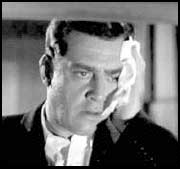AARP Hearing Center
Tsunamis, Nuclear Meltdowns, and the Godzilla Effect
By Bill Newcott, March 14, 2011 06:34 PM

The destroyer rises from the ocean, utterly unexpected, leaves untold destruction in its wake; and gives rise to the threat of nuclear destruction.
If the themes of the 1954 Japanese monster flick Gojira ( Godzilla to us here in the U.S.) eerily echo the earthquake/tsunami/nuclear meltdown nightmare unfolding in Japan, the similarities are not completely coincidental. The fact is, while we consider Godzilla to be a cheapo thriller starring a guy in a lizard suit, for Japanese filmgoers less than a decade after Hiroshima and Nagasaki, Gojira touched on fears that had long populated the nation's nightmares...and which persist until this day.
For centuries, Japan lived and died through its relation to the sea; fishermen have always fed the country; typhoons have been causing upheaval there just about forever. So it makes perfect sense that that Gojira, like a tsunami, arrives from the ocean-the logical path of any island nation's most grievous threats (Compare that to most U.S. science fiction movies- The Day the Earth Stood Still, Invasion of the Body Snatchers, and even this month's Battle Los Angeles-in which the creatures arrive from the skies, the most logical threat to a vast continental power). What's more, besides flattening Tokyo with his stadium-size footprints, Gojira breathes thermonuclear fire, an apparent consequence of his close proximity to a nuclear test blast. So in the movie's universe, even as Japan rebuilds after the real-life nuclear incineration of two cities, the fires of a new nuclear holocaust return to its shores. Today, while Japan's latest nuclear threat plays out in the ruins of its quake-damaged power plants, we are reminded by Gojira that the nation's uneasiness with the atom is well-earned.
In a radio show I did on the movie a couple of years back, I noted that you can't judge Godzilla by the version we grew up with-you know, the one with a pre- Perry Mason Raymond Burr as an American journalist (named Steve Martin!) witnessing the havoc as it unfolds in Tokyo.

The Burr character was created, and his scenes filmed, exclusively for the U.S. release, and large portions of the original version were cut. Most egregiously, the "mad scientist" of the U.S. version is, in the original, a humanitarian scientist trying to balance the destruction of Gojira with the implications of his new monster-killing technology being loosed on the world at large.
If you do yourself the great favor of getting a hold of the recently restored Gojira director's cut, you'll find amidst all the explosions and fleeing citizenry a solemn meditation on the seemingly endless cycle of human invention, the unintended consequences of human invention, and the creation of new inventions to undo the damage done by the old inventions.
Gojira doesn't often get mentioned in the same breath with the works of Akira Kurosawa ( The Magnificent Seven, Ran), or the great animator Hayao Miyazaki ( Spirited Away), but like them, it reflects that unique Japanese knack for incorporating the culture's distinctive mix of history, myth, and complex sociology into its art.

As the talking heads at CNN and Fox News continue to speculate about how the people of Japan will respond to this unprecedented disaster, I'm pretty sure the definitive answers will come in the next few years, as the nation's artists come to terms with the awful events of the past weeks.































































